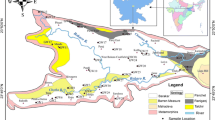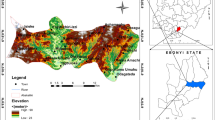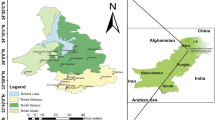Abstract
The south west coast of Kanyakumari district in Tamil Nadu, India, is significantly affected by seawater intrusion and diffusion of pollutants into the aquifers due to unregulated beach placer mining and other anthropogenic activities. The present study investigates the vulnerability of the coastal aquifers using Geographic Information System (GIS)-based DRASTIC model. The seven DRASTIC parameters have been analyzed using the statistical equation of this model to demarcate the vulnerable zones for aquifer contamination. The vulnerability index map is prepared from the weighted spatial parameters, and an accounting of total index value ranged from 85 to 213. Based on the categorization of vulnerability classes, the high vulnerable zones are found near the beach placer mining areas between Manavalakurichi and Kodimanal coastal stretches. The aquifers associated with settlements and agricultural lands in the middle–eastern part have experienced high vulnerability due to contaminated water bodies. Similarly, the coastal areas of Thengapattinam and Manakudi estuary and around the South Tamaraikulam have also been falling under high vulnerability condition due to backwater and saltpan. In general, the nearshore region except the placer mining zone and the backwater has a moderately vulnerable condition, and the vulnerability index values range from 149 to180. Significantly, the northern and northeastern uplands and some parts of deposition zones in the middle–south coast have been identified as low to no vulnerable conditions. They are structurally controlled by various geological features such as charnockite, garnet biotite gneiss and granites, and sand dunes, respectively. The aquifer vulnerability assessment has been cross-verified by geochemical indicators such as total dissolved solids (TDS), Cl−, HCO3 −, and Cl−/HCO3 − ratio. The high ranges of TDS (1,842––3,736 mg/l) and Cl− (1,412––2,112 mg/l) values are well correlated with the observed high vulnerable zones in the study area. The Cl−/HCO3 − ratio (7.13 to 12.18) of the high vulnerable zone obviously indicates deterioration of the aquifer contamination. Sensitivity analysis has also been performed to evaluate sensitivity of the individual DRASTIC parameters to aquifer vulnerability. This reveals the net recharge rate and groundwater table depth are becoming more sensitive to aquifer contamination. It is realized that the GIS is an effective platform for aquifer vulnerability mapping with reliable accuracy, and hence, the study is more useful for sustainable water resource management and the aquifer conservation.













Similar content being viewed by others
References
Al-Adamat, R. A. N., Foster, I. D. L., & Baban, S. M. J. (2003). Groundwater vulnerability and risk mapping for the basaltic aquifer of the Azraq Basin of Jordan using GIS, remote sensing and DRASTIC. Applied Geography, 23, 303–324.
Albinet, M., & Margat, J. (1970). Groundwater pollution vulnerability mapping. Bulletindu Bureau de Researches Geologicques et Minieres Bull BRGM (2nd Series), 3(4), 13–22.
Aller, L., Bennet, T., Lehr, J. H., Petty, R. J., Hackett, G. (1987) DRASTIC; a standardized system for evaluating groundwater pollution potential using hydrogeologic settings. http://www.epa.gov/region5/waste/clintonlandfill/PDFClintonLFChemicalWaste_USEPAApplication/cl_130.pdf. Accessed 20 January 201.
Anwar, M., Prem, C. C., & Rao, V. B. (2002). Evaluation of groundwater potential of Musi River catchment using DRASTIC index model. In Proceedings of the international conference (pp. 399–409). Hyderabad: B. S. Publishers.
Baalousha, H. (2006). Vulnerability assessment for the Gaza Strip, Palestine using DRASTIC. Environmental Geology, 50, 405–414.
Baalousha, H. (2010). Assessment of a groundwater quality monitoring network using vulnerability mapping and geostatistics: a case study from Heretaunga Plains, New Zealand. Agricultural Water Management, 97(2), 240–246.
Babiker, I. S., Mohammed, M. A. A., Hiyama, T., & Kato, K. (2005). A GIS-based DRATIC model for assessing aquifer vulnerability in Kakamigahara Heights, Gifu Prefecture, central Japan. Science of the Total Environment, 345, 127–140.
Chae, G., Kim, K., Yun, S., Kim, K., Kim, S., Choi, B., Kim, H., & Rhee, C. W. (2004). Hydrogeochemistry of alluvial groundwaters in an agricultural area: an implication for groundwater contamination susceptibility. Chemosphere, 55(3), 369–378.
Chandrasekar, N., Selvakumar, S., Srinivas, Y., John Wilson, J. S., Simon Peter, T., & Magesh, N. S. (2013). Hydrogeochemical assessment of groundwater quality along the coastal aquifers of southern Tamil Nadu, India. Environmental Earth Sciences. doi:10.1007/s12665-013-2864-3.
Chidambaram, S., Senthil Kumar, G., Prasanna, M. V., John Peter, A., Ramanthan, A. L., & Srivasamoorthy, K. (2009). A study on the hydrogeology and hydrogeochemistry of groundwater from different depths in a coastal aquifer: Annamalai Nagar, Tamilnadu, India. Environmental Geology, 57, 59–73.
Cimino, C., Cosentino, A., Oieni, L., & Tranchina. (2008). A geophysical and geochemical approach for seawater intrusion assessment in the Acquedolci coastal aquifer (Northern Sicily). Environmental Geology, 55, 1473–1482.
Dawoud, M. A., Darwish, M. M., & El-Kady, M. M. (2005). GIS-based groundwater management model for Western Nile Delta. Water Resources Research, 19, 585–604.
Edet, A. E., Worden, R. H., Mohammed, E. A., & Preston, M. R. (2012). Hydrogeochemical processes in a populated shallow Coastal Plain Sand Aquifer southeastern Nigeria. Environmental Earth Sciences, 65, 1933–1953.
El-Naqa, A. (2004). Aquifer vulnerability assessment using the DRASTIC model at Russeifa landfill, northeast Jordan. Environmental Geology, 47(1), 51–62.
Faye, S., Maloszewski, P., Stichler, W., Trimborn, P., Faye, S. C., & Gaye, C. B. (2005). Groundwater salinization in the Saloum (Senegal) delta aquifer: minor elements and isotopic indicators. Science of the Total Environment, 343, 243–259.
Fritch, T. G., McKnight, C. L., Yelderman, J. C., Jr., & Arnold, J. G. (2000). An aquifer vulnerability assessment of the paluxy aquifer, central Texas, using GIS and a modified DRASTIC approach. Environmental Management, 25, 337–345.
Gogu, R. C., & Dassargues, A. (2000). Sensitivity analysis for the EPIK method of vulnerability assessment in a small karstic aquifer, Southern Belgium. Hydrogeology Journal, 8(3), 337–345.
Guo, H., & Wang, Y. (2004). Specific vulnerability assessment using the MLPI model in Datong city, Shanxi province, China. Environmental Geology, 45, 401–407.
Herlinger, R., Jr., & Viero, A. P. (2006). Evaluation of contaminants retention in soils from Viama˜o District, Rio Grande do Sul State, Brazil. Environmental Geology, 50, 47–54.
Kabera, T., & Zhaohui, L. (2008). A GIS based DRASTIC model for assessing groundwater in shallow aquifer in Yuncheng Basin, Shanxi, China. Research Journal of Applied Sciences, 3(3), 195–205.
Kalinski, R. J., Kelly, W. E., Bogardi, I., Ehrman, R. L., & Yamamoto, P. D. (1994). Correlation between DRASTIC vulnerabilities and incidents of VOC contamination of municipal wells in Nebraska. Groundwater, 32(1), 31–34.
Kaliraj, S., Chandrasekar, N., & Magesh, N. S. (2013). Evaluation of coastal erosion and accretion processes along the southwest coast of Kanyakumari, Tamil Nadu using geospatial techniques. Arabian Journal of Geosciences. doi:10.1007/s12517-013-1216-7.
Kim, Y. J., & Hamm, S. (1999). Assessment of the potential for groundwater contamination using the DRASTIC/EGIS technique, Cheongju area, South Korea. Hydrogeology Journal, 7(2), 227–235.
Krishna Kumar, S., Magesh, N. S., & Chandrasekar, N. (2012a). Trace element concentration in groundwater, Tuticorin City, Tamil Nadu, India. Bulletin of Environmental Contamination and Toxicology, 88(6), 876–879.
Krishna Kumar, S., Bharani, R., Magesh, N. S., Godson, P. S., & Chandrasekar, N. (2014). Hydrogeochemistry and groundwater quality appraisal of part of south Chennai coastal aquifers, Tamil Nadu, India using WQI and fuzzy logic method. Applied Water Science. doi:10.1007/s13201-013-0148-4.
Krishna Kumar, S., Chandrasekar, N., Seralathan, P., Godson, P. S., & Magesh, N. S. (2012b). Hydrogeochemical study of shallow carbonate aquifers, Rameswaram Island, India. Environmental Monitoring Assessment, 184, 4127–4138.
Lake, I. R., Lovett, A. A., Hiscock, K. M., Betson, M., Foley, A., Sunnenberg, G., Evers, S., & Fletcher, S. (2003). Evaluating factors influencing groundwater vulnerability to nitrate pollution: developing the potential of GIS. Journal of Environmental Management, 68(3), 315–328.
Leone, A., Ripa, M. N., Uricchio, V., Deák, J., & Vargay, Z. (2009). Vulnerability and risk evaluation of agricultural nitrogen pollution for Hungary’s main aquifer using DRASTIC and GLEAMS models. Journal of Environmental Management, 90(10), 2969–2978.
Lodwik, W. A., Monson, W., & Svobada, L. (1990). Attribute error and sensitivity analysis of maps operation in geographical information systems—suitability analysis. International Journal of Geographical Information System, 4(4), 413–428.
Magesh, N. S., & Chandrasekar, N. (2013). Evaluation of spatial variations in groundwater quality by WQI and GIS technique: a case study of Virudunagar District, Tamil Nadu, India. Arabian Journal of Geosciences, 6, 1883–1898.
Magesh, N. S., Krishnakumar, S., Chandrasekar, N., & Soundranayagam, J. P. (2013). Groundwater quality assessment using WQI and GIS techniques, Dindigul district, Tamil Nadu, India. Arabian Journal of Geosciences, 6(11), 4179–4189.
McLay, C. D. A., Dragten, R., Sparling, G., & Selvarajah, N. (2001). Predicting groundwater nitrate concentrations in a region of mixed agricultural land use: a comparison of three approaches. Environmental Pollution, 115, 191–204.
Melloul, A., & Collin, M. (1994). Water quality factor identification by the principal components statistical method. Water Science and Technology, 34, 41–50.
Merchant, J. (1994). GIS-based groundwater pollution hazard assessment: a critical review of the DRASTIC model. Photogrammetry Engineering and Remote Sensing, 60(9), 1117–1127.
Mohammadi, Z., Zare, M., & Sharifzade, B. (2012). Delineation of groundwater salinisation in a coastal aquifer, Bousheher, South of Iran. Environmental Earth Sciences. doi:10.1007/s12665-012-1591-5.
Mondal, N. C., Singh, V. P., & Singh, V. S. (2011). Hydrochemical characteristic of coastal aquifer from Tuticorin, Tamilnadu, India. Environmental Monitoring and Assessment, 175, 531–550.
Napolitano, P., & Fabbri, A. G. (1996) Application of Geographic Information Systems in Hydrology and Water Resources Management. In Proceedings of the HydroGIS'96 Conference (pp. 559–566). Vienna, Austria.
Nganje, T. N., Edet, A. E., Ibok, U. J., Ukpabio, E. J., Ibe, K. A., & Neji, P. (2012). Polycyclic aromatic hydrocarbons in surface water and soil in the vicinity of fuel-oil spillage from a tank farm distribution facility, Esuk Utan, Calabar Municipality, Nigeria. Environmental Earth Sciences, 67, 81–90.
Ozler, H. M. (2002). Hydrochemistry and salt-water intrusion in the Van aquifer, East Turkey. Environmental Geology, 43, 759–775.
Pacheco, F. A. L., & Landim, P. M. B. (2005). Two-way regionalized classification of multivariate data sets and its application to the assessment of hydrodynamic dispersion. Mathematical Geology, 37(4), 393–417.
Pacheco, F. A. L. (1998). Application of correspondence analysis in the assessment of groundwater chemistry. Mathematical Geology, 30(2), 129–161.
Pacheco, F. A. L., & Sanches Fernandes, L. F. (2013). The multivariate statistical structure of DRASTIC model. Journal of Hydrology, 476, 442–459.
Piscopo, G. (2001) Groundwater vulnerability map explanatory notes—Castlereagh Catchment. http://www.water.nsw.gov.au/ArticleDocuments/34/quality_groundwater_castlereagh_map_notes.pdf. Accessed 10 April 2013.
Prasad, R., Singh, V. S., Krishnamaacharyulu, S. K. G., & Pallavi, B. (2011). Application of drastic model and GIS: for assessing vulnerability in hard rock granitic aquifer. Environmental Monitoring and Assessment, 176, 143–155.
Rahman, A. (2008). A GIS based DRASTIC model for assessing groundwater vulnerability in shallow aquifer in Aligarh, India. Applied Geography, 28(1), 32–53.
Remesan, R., & Panda, R. K. (2008). Groundwater vulnerability assessment, risk mapping, and nitrate evaluation in a small agricultural watershed: using the DRASTIC model and GIS. Environmental Quality Management, 17(4), 53–75.
Revelle, R. (1941). Criteria for recognition of seawater in groundwaters. Transactions American Geophysical Union, 22, 593–597.
Rupert, M. G. (2001). Calibration of the DRASTIC groundwater vulnerability mapping method. Groundwater, 39, 625–630.
Saidi, S., Bouri, S., & Dhia, H. B. (2013). Groundwater management based on GIS techniques, chemical indicators and vulnerability to seawater intrusion modelling: application to the Mahdia–Ksour Essaf aquifer, Tunisia. Environmental Earth Sciences, 70, 1551–1568.
Sami, K. (1992). Recharge mechanisms and geochemical processes in a semi-arid sedimentary, Eastern Cape, South Africa. Journal of Hydrology, 139, 27–48.
Sarath Prasanth, S. V., Magesh, N. S., Jitheshlal, K. V., Chandrasekar, N., & Gangadhar, K. (2012). Evaluation of groundwater quality and its suitability for drinking and agricultural use in the coastal stretch of Alappuzha District, Kerala, India. Applied Water Science, 2, 165–175.
Saro, L. (2003). Evaluation of waste disposal site using the DRASTIC system in the Southern Korea. Environmental Geology, 44, 654–664.
Secunda, S., Collin, M., & Melloul, A. J. (1998). Groundwater vulnerability assessment using a composite model combining DRASTIC with extensive land use in Israel’s Sharon region. Journal of Environmental Management, 54, 39–57.
Selvakumar, S., Chandrasekar, N., & Magesh, N. S. (2012). Preliminary investigation of groundwater quality along the coastal aquifers of southern Tamil Nadu using GIS techniques. Bonfring International Journal of Industrial Engineering and Management Science, 2(1), 46–52.
Shukla, S., Mostaghimi, S., Shanholtz, V. O., & Collins, M. C. (1998). A GIS-based modeling approach for evaluating groundwater vulnerability to pesticides. Journal of the American Water Resources Association, 34(6), 1275–1293.
Sinan, M., & Razack, M. (2009). An extension to the DRASTIC model to assess groundwater vulnerability to pollution: application to the Haouz aquifer of Marrakech (Morocco). Environmental Geology, 57, 349–363.
Singh, V. S., & Gupta, C. P. (1986). Hydrogeological parameter estimation from pumping test on large diameter well. Journal of Hydrology, 87, 223–232.
Sivakumar, C., & Elango, L. (2008). Assessment of water quality in Kalpakkam region, Tamil Nadu. Nature, Environment and Pollution Technology, 7(4), 687–691.
Sivasubramanian, P., Balasubramanian, N., Soundranayagam, J. P., & Chandrasekar, N. (2013). Hydrochemical characteristics of coastal aquifers of Kadaladi, Ramanathapuram District, Tamilnadu, India. Applied Water Science, 3, 603–612.
Srinivasamoorthy, K., Vasanthavigar, M., Chidambaram, S., Anandhan, P., & Sarma, V. S. (2011). Characterisation of groundwater chemistry in an eastern coastal area of Cuddalore district, Tamil Nadu. Journal of Geological Society of India, 78(6), 549–558.
Stigter, T. Y., Ribeiro, L., & Dill, A. M. M. C. (2006). Evaluation of an intrinsic and a specific vulnerability assessment method in comparison with groundwater salinisation and nitrate contamination levels in two agricultural regions in the south of Portugal. Hydrogeology Journal, 14, 79–99.
Subba Rao, N., Surya Rao, P., & Devavarma, D. (2013). Spatial variations of groundwater vulnerability using cluster analysis. Journal of Geological Society of India, 81, 685–697.
Thirumalaivasan, D., Karmegam, M., & Venugopal, K. (2003). AHP-DRASTIC: software for specific aquifer vulnerability assessment using DRASTIC model and GIS. Environmental Model and Software, 18(7), 645–656.
Tovar, M., & Rodriguez, R. (2004). Vulnerability assessment of aquifers in an urban–rural environment and territorial ordering in Leon, Mexico. Geofisica International, 43(4), 603–609.
Ugbaja, A. N., & Edet, A. E. (2004). Groundwater pollution near shallow waste dumps in southern Calabar, Southeastern Nigeria. Global Journal of Geological Sciences, 2, 199–206.
United States Environmental Protection Agency. (1985). DRASTIC: a standard system for evaluating groundwater pollution potential using hydrogeological settings (pp. 163–165). Ada: EPA, USA.
Vengosh, A., Spivack, A. J., Artzi, Y., & Ayalon, A. (1999). Geochemical and boron, strontium isotopic constrains on the origin of the salinity in groundwater from the Mediterranean coast of Israel. Water Resources Research, 35, 1877–1894.
Vrba, J., & Zaporozec, A. (1994). Guide book on mapping groundwater vulnerability. International contributions to hydrology. Hannover: International Association of Hydrogeologists, Heinz Heise.
Wang, Y., Ma, T., & Luo, Z. (2001). Geostatistical and geochemical analysis of surface water leakage into groundwater on a regional scale: a case study in the Liulin karst system, northwestern China. Journal of Hydrology, 246, 223–234.
Werner. (2010). A review of seawater intrusion and its management in Australia. Hydrogeology Journal, 18, 281–285.
Worrall, F., & Besien, T. (2005). The vulnerability of groundwater to pesticide contamination estimated directly from observations of presence or absence in wells. Journal of Hydrology, 303(1–4), 92–107.
Xiaahu, W. (2008). A GIS based DRASTIC model for assessing shallow groundwater vulnerability in the Zhangy Basin, north western China. Environmental Geology, 57, 1435–1442.
Zhang, R., Hamerlinck, J. D., Gloss, S. P., & Munn, L. (1996). Determination of nonpoint source pollution using GIS and numerical models. Journal of Environmental Quality, 25(3), 411–418.
Acknowledgments
The corresponding author is thankful to DST-INSPIRE Division, Department of Science and Technology (DST), Government of India, for the award of INSPIRE Fellowship SRF (DST/INSPIRE/2011/IF110366 and DST/AORC-IF/UPGRD/2013-14/509) for pursuing his Ph.D Degree Programme.
Author information
Authors and Affiliations
Corresponding author
Rights and permissions
About this article
Cite this article
Kaliraj, S., Chandrasekar, N., Peter, T.S. et al. Mapping of coastal aquifer vulnerable zone in the south west coast of Kanyakumari, South India, using GIS-based DRASTIC model. Environ Monit Assess 187, 4073 (2015). https://doi.org/10.1007/s10661-014-4073-2
Received:
Accepted:
Published:
DOI: https://doi.org/10.1007/s10661-014-4073-2




